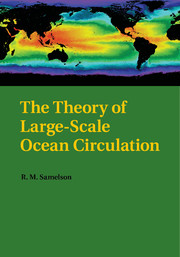Book contents
- Frontmatter
- Contents
- Preface
- 1 Basic Physical Principles and Equations
- 2 Reduced Equations for Large-Scale Motion
- 3 Planetary Geostrophic Vorticity Dynamics
- 4 Stratified Large-Scale Flow
- 5 Circulation in a Simple Rectangular Basin
- 6 Eddy-Driven Subsurface Motion
- 7 Circumpolar Flow
- 8 Mid-Depth Meridional Overturning
- 9 Thermohaline Effects
- 10 Theory and Observation
- Exercises
- References
- Index
8 - Mid-Depth Meridional Overturning
Published online by Cambridge University Press: 07 October 2011
- Frontmatter
- Contents
- Preface
- 1 Basic Physical Principles and Equations
- 2 Reduced Equations for Large-Scale Motion
- 3 Planetary Geostrophic Vorticity Dynamics
- 4 Stratified Large-Scale Flow
- 5 Circulation in a Simple Rectangular Basin
- 6 Eddy-Driven Subsurface Motion
- 7 Circumpolar Flow
- 8 Mid-Depth Meridional Overturning
- 9 Thermohaline Effects
- 10 Theory and Observation
- Exercises
- References
- Index
Summary
Meridional Overturning Circulations
An essential element of the circulation of the Earth's ocean is the large-scale overturning flow that spans its full meridional reach, from the high southern to the high northern latitudes. To represent this flow, the single-hemisphere basin must be extended across the equator so that it reaches both the high southern and the high northern latitudes. Such a double-hemisphere rectangular basin, again with a circumpolar connection at the high southern latitudes, may be considered a simple model of the Atlantic sector of the world ocean (Figure 8.1). The extreme southern and northern latitude of the model basin, y = yS and y = YN, will now be in the southern and northern hemisphere, respectively. The western and eastern boundaries remain at x = xW and x = xE, with periodic boundary conditions for the circumpolar connection at y- < y < y+, z > -Hs.
This idealized basin retains the basic structure of the Atlantic basin, including the important circumpolar connection in the Southern Ocean. Despite neglecting many potentially significant features, including the second existing connection through the Bering Strait and the Arctic and Pacific Oceans as well as all the other complexities of seafloor topography and coastal and island geometry, it provides a useful starting point for the exploration of fundamental aspects of the large-scale overturning circulation. In such a simplified two-hemisphere basin, the circulation patterns that are naturally restricted to a single hemisphere, such as the subtropical and subpolar gyres and the circumpolar current, can be anticipated to retain the basic features and character that they possess in a single-hemisphere basin.
- Type
- Chapter
- Information
- The Theory of Large-Scale Ocean Circulation , pp. 128 - 145Publisher: Cambridge University PressPrint publication year: 2011
- 1
- Cited by

